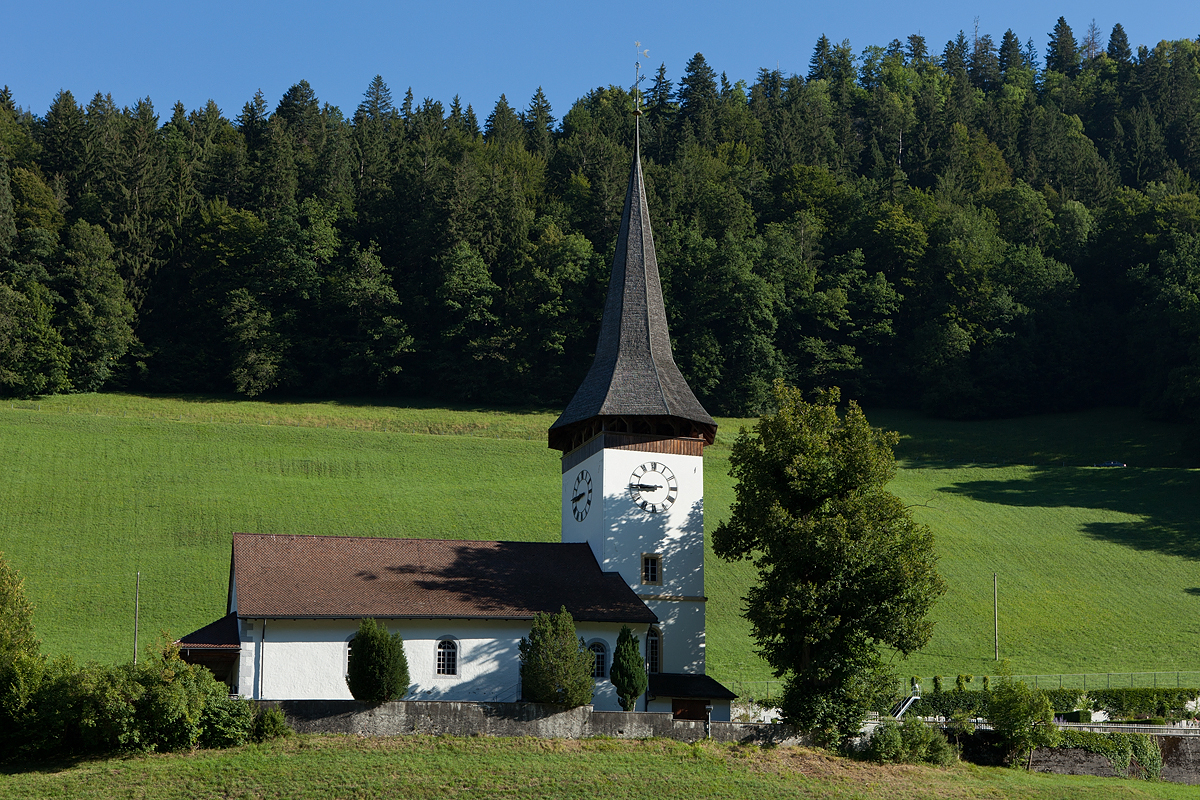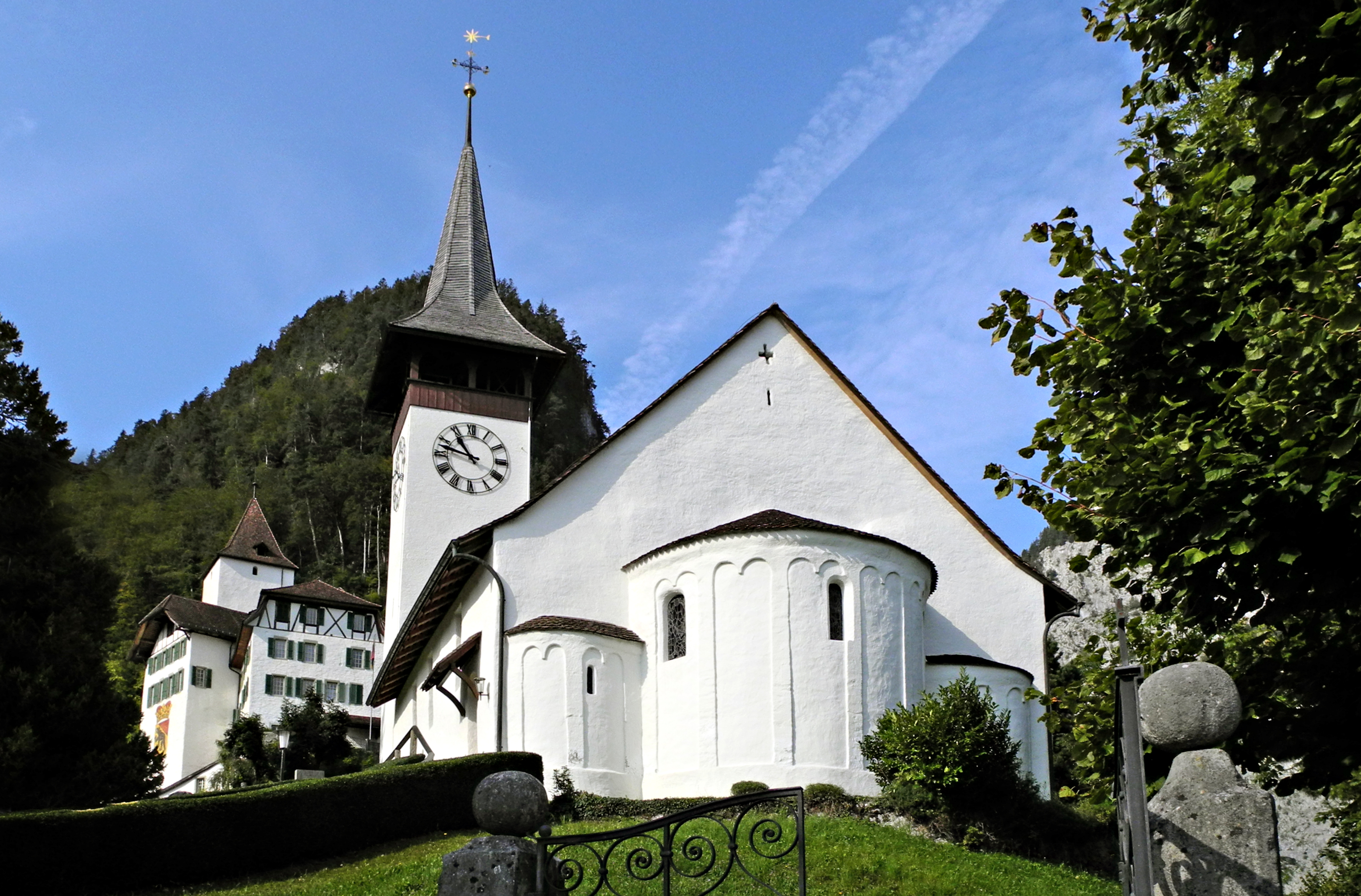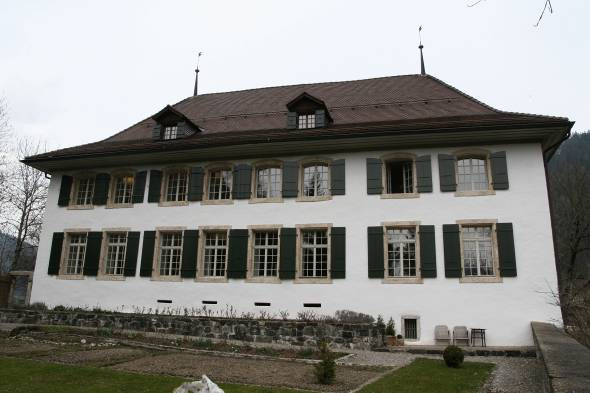|
Simmental
The Simmental ( en, Simme Valley) is an Swiss Alps, alpine valley in the Bernese Oberland of Switzerland. It expands from Lenk to Boltigen, in a more or less south-north direction (Obersimmental (district), Obersimmental), and from there to the valley exit at Wimmis near Spiez it takes a west-east orientation (Niedersimmental (district), Niedersimmental). It comprises the municipalities of Lenk, St. Stephan, Switzerland, St. Stephan, Zweisimmen, Boltigen, Oberwil im Simmental, Oberwil, Därstetten, Erlenbach im Simmental, Erlenbach, Diemtigen and Wimmis. The Simme flows through the valley. Some villages play a role in the winter tourism of the region of Bern, such as Lenk or Zweisimmen. From Zweisimmen the resorts of Gstaad and Château-d'Œx can be reached. Further up is the Jaun Pass, which is crossed to go from Bulle to Canton of Fribourg, Fribourg, as well as the Hahnenmoos, which links Lenk with Adelboden. References {{Coord, 46.55, N, 7.36, E, source:dewiki_region:C ... [...More Info...] [...Related Items...] OR: [Wikipedia] [Google] [Baidu] |
Erlenbach Im Simmental
Erlenbach im Simmental is a Municipalities of Switzerland, municipality in the district of Niedersimmental (district), Niedersimmental in the Cantons of Switzerland, canton of Bern (canton), Bern in Switzerland. History Erlenbach im Simmental is first mentioned in 1180-81 as ''Arlunbach''. The oldest trace of humans in the area is the Paleolithic Chilchlihöhle cave. Neolithic remains have been discovered at Branteschopf Schwynbalm. Other prehistoric traces include the Bronze Age and Switzerland in the Roman era, Roman era artifacts at Balzenberg and Unterklusi and a horde of Roman coins at Stockhorn. After the Fall of the Western Roman Empire, the region remained inhabited. The Earthworks (archaeology), earthen fortification at Chastel probably dates to the Middle Ages. By the High Middle Ages there were at least three castles or forts in the modern municipality, though only ruins remain. The Freiherr von Erlenbach first appears in records in 1133. When the Erlenbach f ... [...More Info...] [...Related Items...] OR: [Wikipedia] [Google] [Baidu] |
Oberwil Im Simmental
Oberwil im Simmental is a municipality in the Frutigen-Niedersimmental administrative district in the canton of Bern in Switzerland. History Oberwil is first mentioned in 1278 as ''Oberwile''. During the Paleolithic era (20,000-10,000 BC) humans lived in several caves above the valley floor during the summer. The caves, Schnurenloch, Mamilchloch, Zwergliloch and Chniechälebalm, contained about 5,000 bones from the now extinct cave bear which the inhabitants had butchered. While no human remains were discovered, a number of stone tools were found. Today the tools and bones are at the Historical Museum of Bern while the caves can be visited with tour groups. These caves and other nearby rock shelters continued to be used through the Neolithic, the late Bronze Age and into the Middle Ages. After the collapse of the Western Roman Empire, Alamanni tribes settled in the Simmen valley and established villages and alpine pastures. In 994, the royal estate at Wimmis and part of Ob ... [...More Info...] [...Related Items...] OR: [Wikipedia] [Google] [Baidu] |
Lenk
Lenk im Simmental (or simply Lenk) is a Municipalities of Switzerland, municipality in the Obersimmental-Saanen (administrative district), Obersimmental-Saanen administrative district in the Cantons of Switzerland, canton of Bern (canton), Bern in Switzerland. History Lenk is first mentioned in 1370 as ''An der Leng''. The oldest traces of a settlement in the area come from neolithic artifacts that have been found scattered around the municipality. During the Bronze Age Burgbühl and Bürstehubel were both fortified. Under the Switzerland in the Roman era, Romans the area was on along a major north–south road that passed over the Rawil Pass, Rawil and Kaltwasser Passes. They built a way station and a small shrine at the Iffigsee and a road and lime kiln at Iffigenalp. By the Middle Ages the Bronze Age fortifications were reoccupied and the area was split between the ''Herrschaft (territory), Herrschaft'' of Mannenberg and the estates of the Freiherr von Raron. The lands p ... [...More Info...] [...Related Items...] OR: [Wikipedia] [Google] [Baidu] |
Bernese Oberland
The Bernese Oberland ( en, Bernese Highlands, german: Berner Oberland; gsw, Bärner Oberland; french: Oberland bernois), the highest and southernmost part of the canton of Bern, is one of the canton's five administrative regions (in which context it is referred to as ''Oberland'' without further specification). It constitutes the Alpine region of the canton and the northern side of the Bernese Alps, including many of its highest peaks, among which the Finsteraarhorn (), the highest in both range and canton. The region essentially coincides with the upper basin of the Aare, the latter notably comprehending Lake Thun and Lake Brienz, the two large lakes of the region. On the banks of the lakes or the Aare are the main settlements of Thun, Spiez, Interlaken, Brienz and Meiringen. The numerous side valleys of the Bernese Oberland include a large number of Alpine villages, many of them being tourist resorts and connected by mountain railways to Spiez and Interlaken. The Lötschbe ... [...More Info...] [...Related Items...] OR: [Wikipedia] [Google] [Baidu] |
Boltigen
Boltigen is a municipality in the Obersimmental-Saanen administrative district in the canton of Bern in Switzerland. Boltigen is a mixed community, with traits both of a burgess community and a village community. Beside it, there is also a reformed evangelical Church community. The history of the community goes back to 1386 and the so-called ''Freiheitsbrief von 1386''. The community president is Hermann Maurer, since 1 January 2005. History Boltigen is first mentioned in 1276. The oldest trace of a settlement in the area is the mesolithic shelter in the ''Ranggiloch'' cave. A few Bronze Age artifacts have also been found. During the Middle Ages there were forts or castles at Simmenegg, Eichstalden and Laubegg though all three have fallen into ruin. Many of the villages and '' Bäuerten'' were founded in the Early Middle Ages and grew slowly over the following centuries. The villages and farm lands came under Bernese control partly in 1386 and completely in 1391. When Ber ... [...More Info...] [...Related Items...] OR: [Wikipedia] [Google] [Baidu] |
Simmental Switzerland
The Simmental ( en, Simme Valley) is an alpine valley in the Bernese Oberland of Switzerland. It expands from Lenk to Boltigen, in a more or less south-north direction (Obersimmental), and from there to the valley exit at Wimmis near Spiez it takes a west-east orientation (Niedersimmental). It comprises the municipalities of Lenk, St. Stephan, Zweisimmen, Boltigen, Oberwil, Därstetten, Erlenbach, Diemtigen and Wimmis. The Simme flows through the valley. Some villages play a role in the winter tourism of the region of Bern, such as Lenk or Zweisimmen. From Zweisimmen the resorts of Gstaad and Château-d'Œx can be reached. Further up is the Jaun Pass, which is crossed to go from Bulle to Fribourg, as well as the Hahnenmoos, which links Lenk with Adelboden , neighboring_municipalities= Diemtigen, Frutigen, Kandersteg, Lenk im Simmental, Leukerbad (VS), Sankt Stephan , twintowns= } Adelboden is a mountain village and a municipality in Switzerland, located in the Frutigen- ... [...More Info...] [...Related Items...] OR: [Wikipedia] [Google] [Baidu] |
Wimmis
Wimmis is a municipality in the Frutigen-Niedersimmental administrative district in the canton of Bern in Switzerland. History Wimmis is first mentioned in 994 as ''Windemis''. The oldest traces of a settlement in Wimmis include the Mesolithic and Bronze Age settlements on the Chienberg and the Bronze Age and High Middle Ages settlements on the Pintel. Roman era artifacts were found at Engfeld and bronze statue of Emperor Gordian III was found at Tägerstein. The area remained inhabited during the Middle Ages and in 994 King Otto III granted his estates in Wimmis to Selz Abbey. By the 12th or 13th century the Lords of Wimmis or Strättligen built Wimmis Castle above the village. The exact relationship between the two families is unclear, but the Wimmis line became extinct in the mid-13th century and by 1260 the Freiherr von Strättligen owned Wimmis Castle and the surrounding lands. A few years later the castle and lands were incorporated into the extensive holdings of t ... [...More Info...] [...Related Items...] OR: [Wikipedia] [Google] [Baidu] |
Diemtigen
Diemtigen is a village and a municipality of the Frutigen-Niedersimmental administrative district in the canton of Bern in Switzerland. It is located at the northern end of the Diemtigtal elevated on a plateau west above the creek Chirel. In 1986, the community was awarded the Wakker Prize for preservation of its architectural heritage. History Diemtigen is first mentioned in 1257 as ''Diemtingen''. The Diemtigen area was inhabited during the Bronze Age and possibly during the Mesolithic Era. It was permanently inhabited and fortified by the High Middle Ages. The heights above the valleys are home to several castles or castle ruins. No records exist and very little is known about the ruins of Kronegg Castle, above Eggwald, and Grafenstein Castle, above Oey. The third castle, Hasenburg near Diemtigen was first mentioned in 1257 as castrum de Diemtingen and in the 12th and 13th centuries was the seat of the Freiherr von Strättligen. After the 12th century the castle a ... [...More Info...] [...Related Items...] OR: [Wikipedia] [Google] [Baidu] |
Zweisimmen
Zweisimmen is a municipality in the Obersimmental-Saanen administrative district in the canton of Bern in Switzerland. History Zweisimmen is first mentioned in 1228 as ''Duessimenes''. In 1257 it was mentioned as ''Zweinlixhenun''. The oldest trace of a settlement in the area are some scattered mesolithic artifacts from Mannenberg-Riedli. The remains of a Roman era settlement were found at Mannried. During the Middle Ages a significant trade route over the Alps to Valais and Lake Geneva passed through the Zweisimmen region. A number of farming villages probably existed in the area during the Middle Ages. In the 13th and 14th centuries, local nobles built several castles, Upper Mannenberg and Lower Mannenberg, Reichenstein-Terenstein, Blankenburg and Steinegg Castles, to protect and collect taxes from the roads. The villages and castles passed through several noble families until 1378 when the Lord of Düdingen sold the lands to Fribourg following an uprising. After the ... [...More Info...] [...Related Items...] OR: [Wikipedia] [Google] [Baidu] |
Hahnenmoos
The Hahnenmoos Pass (German: ''Hahnenmoospass'') is a mountain pass of the Bernese Alps. The pass crosses the col between the peaks of Regenboldshorn and Albristhorn, at an elevation of . The Hahnenmoos Pass is the lowest pass between the Engstligental, to the east, and the upper Simmental, to the west. The pass is traversed by a hiking track, which connects Adelboden, at an elevation of in the Engstligental, with Lenk, at an elevation of in the Simmental. The track forms part of the Alpine Pass Route, a long-distance hiking trail across Switzerland between Sargans and Montreux. Although a road leads to the pass from Adelboden, the pass can not be traversed by car. In winter the pass is part of a ski area. The ''Berghotel Hahnenmoospass'' is a hotel and restaurant that is located at the summit of the pass and is open in both summer and winter. See also *List of highest paved roads in Switzerland *List of mountain passes in Switzerland This is a list of mountain passes in Swi ... [...More Info...] [...Related Items...] OR: [Wikipedia] [Google] [Baidu] |
Niedersimmental (district)
Niedersimmental District was one of the 26 administrative districts in the canton of Bern, Switzerland. Its capital was the municipality of Wimmis. The district had an area of 319 km² and consisted of 9 municipalities A municipality is usually a single administrative division having corporate status and powers of self-government or jurisdiction as granted by national and regional laws to which it is subordinate. The term ''municipality'' may also mean the go ...: References Former districts of the canton of Bern {{Berne-geo-stub ... [...More Info...] [...Related Items...] OR: [Wikipedia] [Google] [Baidu] |
Därstetten
Därstetten is a municipality in the Frutigen-Niedersimmental administrative district in the canton of Bern in Switzerland. History Därstetten is first mentioned in 1228 as ''Tarenchat''. The village of Weissenburg was first mentioned around 1270 as ''Wisinburc'' and in 1278 as ''Album-castrum''. The oldest trace of a settlement in the area is a single Neolithic artifact found at Stufengrind. During the Middle Ages the land was owned by the Freiherr von Weissenburg, who was first mentioned in 1175. Around the third quarter of the 12th century he donated land along the Simmen river to the Augustinian order for a monastery. The monastery was first mentioned in 1228 along with the surrounding village. Weissenburg Castle was probably built in the mid-13th century and was first mentioned in 1278. In 1368 the Freiherr von Brandis inherited the Weissenburg lands including patronage of the monastery. It continued to expand during the 13th and 14th centuries as nobles donated lan ... [...More Info...] [...Related Items...] OR: [Wikipedia] [Google] [Baidu] |








